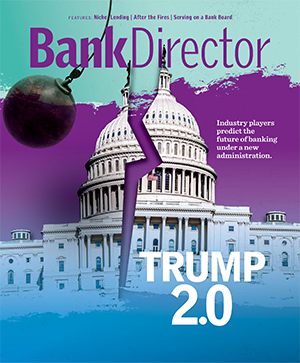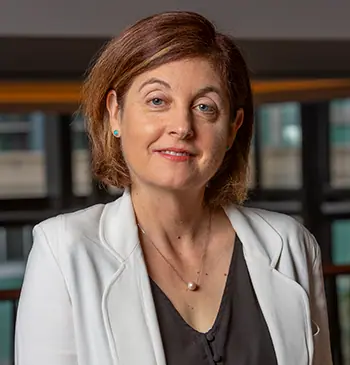
For Your Review
Feds Wash Dirty Laundry
For decades, the U.S. government has expected banks to help them catch criminals, drug lords and terrorists, and enforce U.S. sanctions against certain countries, such as Cuba and Iran.
Not doing so can become very expensive, as the recent settlements against HSBC Bank USA and Standard Chartered have shown. The cases highlight some of the recent changes in anti-money laundering (AML) and Bank Secrecy Act (BSA) enforcement policy that could impact both big banks and small.
Standard Chartered, a U.S. subsidiary of London-based Standard Chartered PLC, agreed to a $327 million settlement with multiple regulators over charges it violated sanctions against the governments of Iran and Libya, among others. During the same December week, HSBC Bank USA, a U.S. subsidiary whose parent company is HSBC Holdings PLC in London, agreed to settle with regulators for $1.9 billion in fines and penalties, the largest in U.S. history for violations of anti-money laundering rules. The government alleged the bank allowed hundreds of millions of dollars from Mexican criminal organizations to pass into the United States, charging the bank with a breakdown in anti-money laundering compliance that lasted several years until about two years ago. The bank has made many attempts in recent years to remediate the problems, including hiring Stuart Levey as chief legal officer last January, a former undersecretary with the U.S. Treasury responsible for terrorism and financial intelligence.
“In the case of HSBC, they got it wrong in a pretty egregious manner and I think our penalty reflects that,” says Jennifer Shasky Calvery, the director of FinCEN, the Financial Crimes Enforcement Network, which investigates financial crimes, and writes and enforces anti-money laundering rules as part of the U.S. Treasury.
The two cases against HSBC and Standard both ramp up the fines significantly for money laundering violations. There have only been 11 money laundering enforcement actions resulting in fines above $5 million in the last nine years, Wachovia Corp. being the largest with $110 million in 2010, according to FinCEN.
Violations of U.S. sanctions against foreign governments are a different category under the U.S. government’s definition, but those fines and the totals collected in recent years have been increasing as well, according to information on the U.S. Treasury’s web site.
Shasky points out that the fines are tied to transactions, the size of the bank and the violations, but even small banks have been hit with penalties. Ocean Bank in Miami, Florida, is a $3.9-billion asset bank forced to pay a $10.9 million penalty for money laundering violations in 2011.
Others changes have been in the works that could significantly impact banks as well.
After a Senate subcommittee report on the HSBC money laundering case in July of last year criticized the Office of the Comptroller of the Currency, the agency issued a notice saying it would start counting money laundering problems as a potential threat to the safety and soundness of a bank, rather than as a consumer compliance issue.
The change is significant in the sense that money laundering problems could now impact the “management” component of a bank’s important regulatory strength score, the CAMELS rating (or Capital Adequacy, Asset Quality, Management, Earnings, Liquidity and Sensitivity to market risk), says Michael Florence, a senior director at consulting firm Treliant Risk Advisors in Washington, D.C. An adverse rating resulting from BSA/AML compliance program deficiencies may suggest broader unsatisfactory risk management practices, he says.
Regulators may slap banks with enforcement actions and restrict their activities, such as acquisitions, if banks fall below the highest ratings.
“I think with the sole exception of mortgage servicing compliance risks, [money laundering is] the top compliance risk banks face today,” says Michael Dawson, a managing director at consulting firm Promontory Financial Group in Washington, D.C. and a former Treasury official himself. “The fines are so high and the remediation so expensive.”
So what is a bank board to do?
Making sure it is getting unfiltered information from the compliance staff is critical, says Beth Moskow-Schnoll, a partner in the Wilmington, Delaware, office of the law firm Ballard Spahr LLP.
Treliant’s Florence says boards need to ask compliance staff what types of problems or potential BSA/AML violations they have uncovered and be able to demonstrate a tactical road map to address those.
“You need a dynamic enterprise-wide risk assessment around money laundering to identify high-risk customers, products, services and geographies,” he says. “A comprehensive and robust AML program must not be considered a big bank requirement. Whether you’re a $100 million bank or a $100 billion bank, the same pillars of AML compliance are required.”
The OCC says that at a minimum, every bank must have a system that provides for internal controls to ensure ongoing compliance; independently tests for compliance conducted by bank personnel or by an outside party; designates an individual or individuals responsible for coordinating and monitoring day-to-day compliance; and provides training for appropriate personnel.
But banks really have to make sure there is culture of compliance in the organization, says FinCen’s Shasky.
“When these questions come up and it’s a choice of profits or compliance, who is making the decision?” says FinCEN’s Shasky. “Where is the board or the most senior officers? What authority has been given to the compliance staff to make the decisions they need to make to effectively protect the institution from reckless action?”
Dawson says some banks get into trouble when they assign the compliance function solely to the chief compliance officer, rather than making compliance a part of the performance review of business unit managers.
“At a really well run bank, the board of directors will set a tone from the top emphasizing the importance of compliance, and then communicate an expectation that all the different divisions need to work together to manage compliance risks,” he says.
The JOBS Act and the Illusion of Liquidity
Tri City Bankshares Corp. in Oak Creek, Wisconsin, is no longer a public company as of August of last year. And it hardly matters. The trading volume of shares is about what it was when the $1.2-billion asset Tri City was registered with the Securities and Exchange Commission. The bid/ask spread in stock trades changed very little. The stock price actually climbed a little bit as of mid-December.
Tri City, like more than 100 other banks, has deregistered from filing with the SEC as a public company, as allowed under the JOBS Act (Jumpstart our Business Startups Act) enacted in April. Previously, banks could only deregister if they had fewer than 300 shareholders. Now the threshold is 1,200 shareholders.
Tri City has about 900 shareholders.
Ron Puetz, the chairman and chief executive officer who has been with the bank for 40 years, can hardly see a downside to deregistering. The bank has no institutional shareholders, no employee stock ownership plans and no acquisitions in the works. About half of the bank is owned by one family.
“There is no doubt there is a six figure savings between accountants and our attorneys reviewing all our filings,” he says.
Looking at volume and pricing for banks that deregistered is hardly conclusive, as there are only a few months of data. While some banks have seen volume and prices fall, others have seen them rise. Overall, contrary to losing liquidity, the median daily volume was flat in November for the deregistered banks compared to their previous average daily volume for three years, according to SNL Financial data. As of early January, the SEC has not issued rules allowing thrift holding companies to deregister, so they aren’t included.
Most of the deregistering companies weren’t listed on a major exchange, so they didn’t get many of the benefits of being a publicly traded company. They were traded over-the-counter or on what is sometimes known as the pink sheets.
Most were small community banks with less than $1 billion in assets. They had no analysts following their stock and almost no media attention whatsoever. Many of them were closely held by insiders.
B.T. Atkinson, a partner at law firm Bryan Cave LLP’s office in Charlotte, North Carolina, says that in previous decades, bank executives had a fascination with being public and seeing their stock quote show up in the local newspaper (back when newspapers ran that sort of thing).
Becoming an SEC filer created an “illusion of liquidity” that didn’t really exist.
“They long since realized it’s not really meaningful unless you have a full public float and significant shares and research being done on your bank,” he says.
The Independent Community Bankers of America had been trying for years to get the SEC to drop the shareholder threshold for community banks in an effort to save them money, says Chris Cole, the senior vice president and senior regulatory counsel for the trade group.
The argument the group used was that banks and thrifts have a ton of information already available publicly, such as the call financial reports submitted to regulators.
The ICBA and the American Bankers Association were unsuccessful in their efforts until the JOBS Act starting moving through Congress, which loosened the rules for start-ups and small businesses to raise money before becoming public filers.
The bill had traction and Sen. Jerry Morgan (R-Kansas) and Rep. Blaine Luetkemeyer (R-Missouri) managed to get the community bank provision included as well, Cole says.
The ICBA wrote up a Q&A for banks that included possible drawbacks to going private, one of which mentioned the “loss of liquidity.” But the loss of liquidity hasn’t been realized so far, Cole says.

Join OUr Community
Bank Director’s annual Bank Services Membership Program combines Bank Director’s extensive online library of director training materials, conferences, our quarterly publication, and access to FinXTech Connect.
Become a Member
Our commitment to those leaders who believe a strong board makes a strong bank never wavers.


